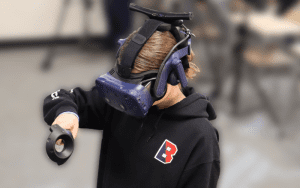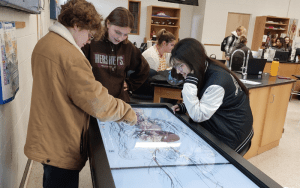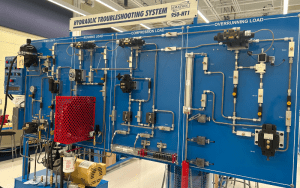
Burlington County Institute of Technology began piloting educational virtual reality and augmented reality in the classroom about six years ago.
When it comes to incorporating educational technology into the curriculum to promote the achievement of all students, school districts that focus on career and technical education may be leading the charge.
That includes the Burlington County Special Services School District and the Burlington County Institute of Technology, which are two separate school districts under a single board of education. BCSSD has about 530 students and BCIT has about 2,060 students. BCIT also has a postsecondary adult division.
Dr. Christopher Nagy, superintendent of the two districts, said he and his colleagues strive to think “like educational futurists.”
Tools in the educational landscape now mirror the world of students, he observed, which combines the science of learning with gaming, social media and immersive and extended reality tools.
Teachers should embrace the new tools that are available, said Danielle Hartman, director of curriculum and instruction at the Burlington County Institute of Technology, who said she’s surprised when new teachers enter the field with a lack of tech savviness.
Eder Joseph, the assistant superintendent who oversees BCIT, said helping teachers hone those skills is important. “And to be honest, there are some high schools that are still stuck in a very traditional model … it could be fear of trying something new,” he said.
But BCSSD and BCIT have strived to adopt technology early – particularly as it relates to immersive and augmented reality tools. And when artificial intelligence made significant strides, district leaders immediately asked, “How do we use this in the classroom?” Hartman said.
“It really has to do with the mindset,” Nagy said “We have constantly been talking growth mindset, innovative mindset, and we want to be risk takers and not worry about failing. We believe you fail by not trying – and we really do promote that.”
It goes beyond “thinking outside the box,” Nagy said. “Our mantra is to go where there is no box and create new pathways,” he said. “Just by saying you want to work outside the box, you are already confining yourself in terms of the possibilities of where you can go.”
With that philosophy in mind, BCIT began piloting educational virtual reality and augmented reality in the classroom about six years ago, Nagy said.
About 300 students in the criminal justice, allied health, and sports medicine programs use virtual reality headsets from Envision Innovations at the Westampton and Medford campuses. Students can participate in 911-call simulations and much more, Hartman said. According to the district, the headsets provide several benefits:
Promotes faster and more profound learning while extending memory retention.
Creates engaging and enjoyable learning experiences, fostering a desire for in-depth learning and enhancing executive brain functions. This leads to tangible benefits such as reduced dropout rates, fewer behavioral problems and improved attention span.
Adapts to diverse learning styles, paces, and abilities, offering a personalized approach.
Serves as an alternative to traditional classroom methods, replacing textbooks and lectures with interactive content.
Provides transformative learning experiences that are individualized, differentiated, self-reflective and intuitive.
Offers memorable experiences through problem-solving, active engagement and interaction.
Encourages empathy by offering a global perspective, helping learners understand the viewpoints of others around the world through practical applications.
Delivers a 360-degree experience that remains fresh and unique with each viewing.
The partnership with Envision has been tremendous, Nagy said.
“I was introduced to the CEO (Alexander Cortez Jr.), who was mainly doing special operations training with proprietary software,” he said. The conversation turned to how the technology could be used in classrooms, and he eventually visited the school district. “He selected us to be the company’s beta incubator if you will,” Nagy said. “Envision has provided us with that runway to have customizable virtual reality and extended reality applications.”
It isn’t just students studying criminal justice who get access to new technology. Students in BCIT’s autobody program can think through how they’d paint a vehicle virtually, saving the district money on paint before they transition to the real thing.
Welding students get a similar opportunity. “Before they touch any steel, metal or other objects, they go through everything virtually,” Nagy said. “We have saved a significant amount of scrap and money from that vantage point – and it has provided a great deal of confidence to our students.”
Autobody students use technology provided by SIMSpray, which combines virtual reality technology with innovative painter training simulations. Welding students use Vertex 360, Millers Augmented and guideWeld VR, Nagy said.
Educational technology is incorporated throughout both BCSSSD and BCIT so that everyone benefits. Among the technologies in place: an augmentative and alternative communication initiative with multiple apps for iPads to address students with a speech or language impairment to provide students with a voice; a Floreo Virtual Reality evidence-based program that utilizes Meta Quest headsets for learners with autism spectrum disorder, ADHD, and anxiety, so they can navigate scenarios in a safe environment; the Interactive Floor and Wall Projection System by Breeze Creative for multiple therapy modalities; Milo the Robot through AI; interactive learning tools provided by Teachers Pay Teachers and more.
Educational technology must be seen as “an investment,” Nagy said. District leaders should consider how many students will be able to use the technology, how it will boost engagement and how it will result in learning that would not otherwise take place.
“These tools have also been found to help considerably with students with disabilities, students who have trouble focusing and even students with autism,” he said.
For many applications, virtual or augmented reality is the only way for students to experience the material beyond the textbook, Nagy said. “There are certain things you just can’t pay for,” Nagy said. “This is where virtual reality and these other technologies come into play.”
As far as where the future of virtual and immersive technologies may lead, Nagy is excited about what’s next. “There is a possibility of leveraging artificial intelligence in such a way that a student would be able to extend their learning at home by working with an avatar of the teacher,” he said, explaining this could allay the teacher shortage.
Education, Nagy believes, is going through a major shift that will permanently change “the way we teach, learn and function in education” – one similar to the move to have one device for every individual student.
“This has been a journey for us – of trying to bring the future to the present and to prepare our staff and students for that next generation of learning,” Nagy said.
Going High-Tech in Hunterdon
A high-tech piece of equipment has been the star attraction at Hunterdon County Vocational School District’s biomedical science program, which was launched about eight years ago after the district received funding via a county Vocational School District Partnership Grant, which was offered by the New Jersey Department of Education to expand access and student opportunities in career and technical education for secondary students.
The Anatomage table, which is made by a company named Anatomage, is a technologically advanced 3D anatomy visualization and virtual dissection tool for anatomy and physiology education.
The table has been a game changer for students who would have otherwise had to rely on textbooks to advance their knowledge, said Jane Griesinger, director of curriculum and instruction and supervisor of academies.
“It is essentially a virtual cadaver,” Griesinger said. “Instead of using a scalpel, they use their finger. “You can cut into the virtual cadaver. You can remove layers. If you want to look at the skeletal system, you can just look at that.”
The Anatomage table allows students to look at specific organs or the front or rear view of a person’s body. “The Anatomage table allows us to take what is typically reserved for medical school or a cadaver lab and take it into the classroom,” she said.
The advanced technology is so much better than looking at pictures in a textbook, Griesinger said.
“It is difficult to look at pages in a book and know where something is situated,” she said. “This allows our students to interact in a more hands-on way.”
The investment has been worth it, Griesinger said. Students in the biomedical science program and health care science program students all have access to an Anatomage table.
“We have one at each school,” she said. “Once you get more than five or six students on it at a given time, it is not as hands on,” she said, noting that classes will often rotate groups of students to give everyone a chance to use the technology.
Dr. Jean Kovacs, an instructor with the Biomedical Sciences Academy who earned a Doctor of Chiropractic degree and worked in private practice for 15 years before earning a teaching certificate, tells students that books and diagrams only teach so much. “When you see it in real life, in person, it just looks so different,” she said. “So, it is amazing to get this firsthand experience.”
The images on the Anatomage table are “actual images from a cadaver,” Kovacs said. “We treat it as though we are in a regular dissection lab.”
Photography is not allowed. “This is a real living person who gave permission to be photographed and put into the system,” she explained.
The Anatomage table delivers an experience almost like the real thing, Kovacs said. “You can’t pull on a muscle and move it to give you an idea of where you are, so you lose that tactile portion of it – and there is no smell to it, which in a way is better,” she said. It’s a great “lead in” to the real thing, allowing students to get the type of exposure they’ll find in a university setting, she said.
District staff members were all in on the technology from the beginning, Griesinger said. “All of our staff members are people with a medical background or are in the biomedical field themselves,” she said. “That said, we did not do a tremendous amount of training, but the equipment is fairly intuitive.”

Hunterdon County Vocational School District’s Biomedical Sciences Academy students using the Anatomage table. Pictured from left to right are: Alex Ford, Mackenzie Holk and Ysabella Leonelli.
Using the tables is like “operating a big, giant iPad,” Kovacs said. “There is nothing you can really mess up,” she said. “You can go back and go forward.”
Older students who are familiar with the Anatomage table come back to help younger students. “We partner with our seniors, who work with the freshmen,” Kovacs said. “They show them how to operate and start it. The older kids have become a great resource, which is amazing … it binds them together and helps them because when they are ready to step up to university, they will be dealing with older students.”
The Anatomage tables have been a great resource, but it may soon be time to buy new models to take advantage of updates, Griesinger said. “Technology only has so much of a useful life, so we might need to think about whether we need to invest in a newer model,” she said, noting that an Anatomage Table costs somewhere between $50,000 and $100,000, with the average cost of the 8.0 model being about $72,000.
While the technology comes at a cost, it gets ample use, with about 50 students having most recently come to freshman orientation. Overall, there are about 200 students in the Biomedical Sciences Academy. “Some kids also come back after school and use it more,” Kovacs said. “They can do independent work on it – and you can also do different games and quizzes and things.”
The board of education has been “fantastic” in supporting the inclusion of technology into the curriculum, Griesinger said. “Because we are a career and technical education school, there is a general recognition that our equipment and technology must be cutting edge,” she said.
Enthusiasm from students indicates that investing in the technology was a great idea, with one student doing a capstone project that revolved around creating a manual for the Anatomage table, complete with lesson plans to promote learning.
“I think we need to be smart about what we do with technology – the way vocational schools are structured in New Jersey makes them a unique environment,” Griesinger said. “There is some technology that every district should incorporate, but I also think there may be some technology that is very specific to a specific career and may be very expensive.” She added, “But there is something to be said for county vocational schools leading the charge and partnering with some comprehensive school districts to make those resources available.”
Focusing on Manufacturing and Applied Science Students in the Academy of Biological Sciences at the Gloucester County Institute of Technology, which is a four-year vocational-technical public high school in Deptford Township that is the only school in the Gloucester County Vocational-Technical School District, also have access to an Anatomage table.
An array of other technology, however, is incorporated into its Advanced Manufacturing & Applied Science Academy, which serves students pursuing careers in innovation, automation, robotics, 3D modeling and 3D printing, new manufacturing technologies and more. Students in the program can earn college credits and industry credentials.
The academy was introduced in 2018 with the passage of the 2018 Securing Our Children’s Future Bond Act, which provided $275 million to grow career and technical education to support New Jersey’s economy.
Michael Dicken, superintendent of the district and a former president of the New Jersey Council of County Vocational-Technical Schools, noted that the advanced manufacturing program welcomed its first cohort of 26 students in the fall. The academy is expected to eventually serve about 200 students.
“This current freshman class was recruited without a building,” Dicken said. “We are expecting a much higher application pool this year than last year.”
The bond act was instrumental in getting the academy up and running, he said, with the county commissioners agreeing to pick up 25% of the cost of its $16 million building housed on the campus of Rowan College of South Jersey in Deptford. The district’s main campus is right next to the college campus.
Schoolwide, Gloucester serves about 1,600 students, and the district strives to help the students of the advanced manufacturing program feel connected to the main campus. “We shuttle them back and forth to assemblies and athletics,” Dicken said. “We are trying to create a balance between being on the main campus and not missing out on a true high school experience but also giving them the intimacy of their own school where they are able to develop their own culture.”
Matthew Woodrow, a teacher of engineering at Gloucester County Institute of Technology, is impressed with the technology available to students. “There are a wide variety of technologies and equipment available to students in Advanced Manufacturing,” he said. “There are portable trainers for learning AC/DC circuits, pneumatics, hydraulics and electric relay controls. There are larger pieces of equipment for learning mechatronics, programmable logic control systems, and electric motor controls. We also have a 3D printer and a tabletop CNC machine.”
The technology encompasses a variety of areas, such as:
An alternating current/direct current circuit tool that students can use for wiring, to turn on bulbs etc.
An electromagnetic system tool with which students can learn about relay controls that can be used to build programmable, logical controllers.
Pneumatic technology that is used by airlines and in other fields.
“We have all kinds of sensors and equipment – students need to understand all of that,” Woodrow said. Students are often amazed when he tells them that they should eventually be able to assemble something that resembles one of the technology trainers that they use.
Whether it is 3D printers, a computer-aided design machine that allows students to digitally create 2D drawings or 3D models of future products, hydraulic equipment or a vertical mill that can cut aluminum and other material, students get to enjoy an immersive technological experience.
“We also have a pretty robust advisory committee, which includes some petroleum companies,” Dicken said. Those members can give the school deep insights into what skills companies are looking for from students when they graduate.
Teachers are heavily invested in using technology to teach students, Woodrow said.
“I was a mechanical engineer who created programmable logic controller systems prior to teaching, so I’m not simply a teacher – I’m an engineer who teaches,” he said. “So, for me, it is getting used to what the equipment is.”
The challenge in running the advanced manufacturing program is that it touches so many different fields, Dicken said. “We have so many different types of students … there is an engineering piece and a traditional trade piece.”

One of the many lab spaces in Gloucester County Institute of Technology’s new Academy of Advanced Manufacturing and Applied Science is designed to educate students in hydraulics.
Keeping up with technology can be difficult for any school district, Dicken said. “But given our mission, we dedicate funds in our general budget to have the most up-to-date equipment,” he said. “People come here to learn careers – and we want to make sure they learn on the most modern equipment possible.”
With that said, Dicken recognizes that his mission leading a vocational school is slightly different than traditional K-12 districts. “As a vocational school, we have to make sure our students are prepared to learn in the workforce,” he said.
Students love being able to learn with the assistance of the latest technology, Woodrow said. “The 26 students we have right now are very engaged,” he said. “I do not have to fight anyone to get work done. They know how class runs: They come in, open up their laptops and get to work. They get on the trainers as their skills go along and they meet different objectives through the online curriculum. It has turned into a self-directed course, where I come in and make sure everyone understands. Right now, we are learning about logic controls. This is stuff I did not see until I was a sophomore at Drexel – and they are seeing it in the second month of their freshman year.”
Woodrow continued, “I don’t envy academic teachers who have to sit and lecture – not that I don’t have to lecture and provide background information. But when you use theoretical knowledge and combine it with practical application of that knowledge, it makes teaching much easier.”
Even with that hands-on piece, however, there is a lot of knowledge students need as a foundation, Woodrow said. “Right now, the math is at about an Algebra 1 level where a typical freshman would be,” he said. “Kids also need to kind of understand ‘What does 1/1000 of an inch look like?’ and ‘How do I equate that to things I have to apply that measurement to?’ It’s more of a practical experience.”
The district’s board of education has been supportive in helping the district weave the latest technology into the curriculum, Dicken said. “We strive to get grants if we can’t find money in the local budget,” he said. “My advice to boards is to reach out to your community and reach out to anyone who can donate items. I also encourage districts to apply for Perkins funding. Look for those resources.”
Take an honest look at how your district fits into the community, he said. “Are you in an agricultural area and do you want to build programs around that? Or do you focus more on academics?” he asked. “Don’t be afraid to ask for help. There are many organizations that will help you or donate equipment.”
“The money is out there,” Woodrow agreed. “You just have to go and find it, but it takes some effort. Our engineering academy has partnered with Lockheed Martin and every year or every other year, depending on what is available, they donate $10,000 to $15,000. You don’t always have to go to your taxpayers – private industry will invest in the future.”
More school districts should focus on incorporating technology into the curriculum, Dicken said. “You have to recognize that the world is changing, and it is only going to change and evolve more in a high-tech environment,” he said. “It is important to give students the tools they need.”
This article originally appeared in the Winter 2024 issue of School Leader magazine by Thomas A. Parmalee, NJSBA’s manager of communications and publications.



